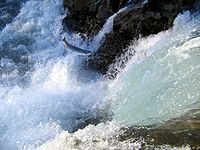
Photo from wikipedia
The importance of live-feed traps farming marine fish species This article analyses the challenges of different live-feed regimes for the rearing of marine finfish larvae and discusses the potential alternative… Click to show full abstract
The importance of live-feed traps farming marine fish species This article analyses the challenges of different live-feed regimes for the rearing of marine finfish larvae and discusses the potential alternative live feeds to avert a future live-feed trap. Live feeds are indispensable for the successful rearing of larvae of most marine fish species. Brine shrimps (Artemia) and rotifers comprise the live feeds of choice in marine aquaculture today. However, their nutritional composition is deficient in especially essential fatty acids, and enrichment with fish oil is needed. Fish oil is considered a limited resource owing to its origin in fully exploited wild fish stocks. Moreover, fluctuations of the natural population of Artemia will, most likely, influence future availability and prices. This emphasizes the need for optimal exploitation of available live-feed resources and development of new sustainable alternatives, such as copepods. An array of solutions to these problems are presented to avoid a future live-feed trap and to reduce dependence on limited resources that influence future production possibilities, species diversification, price volatility and productivity in the aquaculture sector
Journal Title: Aquaculture Research
Year Published: 2017
Link to full text (if available)
Share on Social Media: Sign Up to like & get
recommendations!